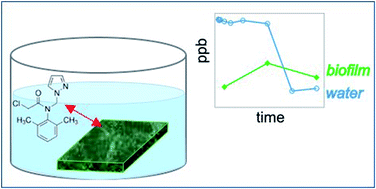Interactions with freshwater biofilms cause rapid removal of common herbicides through degradation – evidence from microcosm studies†
Abstract
We investigated the role of periphyton biofilms for the fate of three common herbicides, i.e. bentazone, metazachlor and metribuzin, at low, environmental levels and 100 times higher, during a 16 days laboratory experiment. We found that herbicide water concentrations were stable during the first 8 days, whereas substantial declines (>78%) occurred between days 8–16 for all three herbicides. These rapid declines were explained only to a small extent (<8% of the total herbicide loss) by biofilm sorption. As herbicide concentrations in light and dark treatments without biofilms were similar, and the applied light regimen did not cover the UV-spectrum, herbicide photolysis was ruled out as a possible explanation for the observed declines. Furthermore, based on the compounds' characteristics, also volatilization was judged negligible. Therefore, we conjecture that the observed declines in herbicides were due to biodegradation and subsequent evasion of 14CO2 that was driven by enzymatic action from heterotrophic microbes. We reason that heterotrophic microbes used herbicide molecules as labile organic C-sources during C-limitation. Future studies should identify the microbial communities and genes involved in biodegradation in order to understand better the role of biofilms for the self-purification of surface waters.

- This article is part of the themed collection: Urgent communications in RSC Environmental Science journals


 Please wait while we load your content...
Please wait while we load your content...